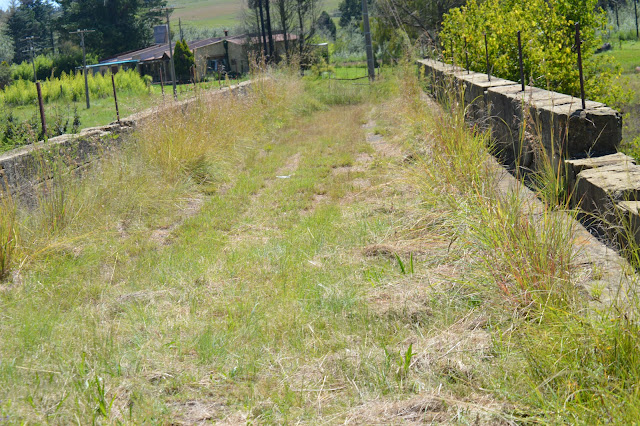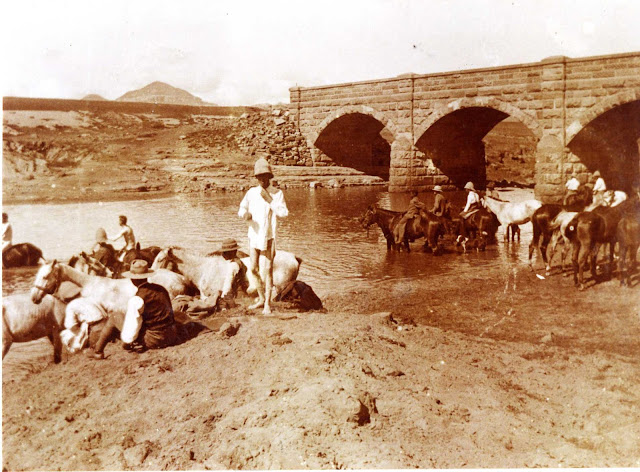We paid a visit to the Platberg Shellhole. It is believed that it was founded in 1928. The Shellhole lapsed rather towards the 1930s. With the 2nd Great War, there was a great influx of returned servicemen, all keen to carry on the true ideals of the Moths.
In 1962 the building in Stuart Street Harrismith was purchased as a Shellhole.
The Flag was hosted it waved in the slight breeze. The dark blue of the naval service, red for the army and light blue for the air force. The Tin Hat and lighted candle remind of the sun which rises and falls over the world’s battlefields, above all known and unknown graves.
Then you walk into the door and the emblem greets you.
The emblem with the tin hat and lighted candle signify the comradeship of the front line. The two rifles with fixed bayonets are leaning as if thrust into the battlefield soil, they are crossed to signify sacrifice and are revered in a token of remembrance. A circle of stars denoted the eternal universe forever that has no end. The twelve stars as in a clock indicate the hours of the day reminding us that every hour presents opportunities of harmony among mankind through tolerance and help.
On entering there is a beautiful collection of a uniform and tin hat.
The members stopped in front of the uniform and show a moment of silence and honour to the fallen soldiers.
“At the going down of the sun and in the morning, we will remember them”
The Shellhole is dedicated to preserving the military history and the people of Harrismith has donated to keep it updated. The display dates back from the Anglo Boer War to modern-day warfare.
On the day of our visit the Shellhole was giving honour to the battle of El Alamein that took place from 8 – 12 November 1942.
During this battle more than 100 000 men were killed, wounded or taken prisoner. The Shellhole was decorated according to the theme.
During the battle of El Alamein my uncle Ignatius (Natie) Barlow was one of the fallen soldiers. Early 1942 they were first to retreat to a little railway station called El Alamein. They were supposed to patrol the desert. On 6 July 1942 Nati and two of comrades were blown away by a German bomb that hit their panzer car. They died instantly. Their temporary burial ground would be the desert. After the battle, they were re-buried in El Alamein Military Cemetary.
“Where the tree has fallen let it lie”
During the war, the Cartoonist, Bruce Bairnsfather’s Old Bill sketches boosted the morale at home and on the front line. The trench humour, cubby pipe-smoking British “Tommy” during the First World War. A weary Old Bill, pictured top left is also part of the Platberg Shellhole.
On the 11th hour of the 11th day of the 11th month when the guns fell silent – we will remember
We all know about the poppies on Remembrance Day. In the spring of 1915, John McCrae was inspired by the sight of poppies growing in battle-scarred fields and he wrote that famous poem – Flanders Fields. After the First World War, the poppy has adopted a symbol of Remembrance.
In Flanders Fields
by John McCrae, May 1915
In Flanders Fields, the poppies blow
Between the crosses, row on row,
That mark our place; and in the sky
The larks, still bravely singing, fly
Scarce heard amid the guns below.
We are the Dead. Short days ago
We lived, felt dawn, saw sunset glow,
Loved and were loved, and now we lie
In Flanders fields.
Take up our quarrel with the foe:
To you from failing hands we throw
The torch; be yours to hold it high.
If ye break faith with us who die
We shall not sleep, though poppies grow
In Flanders fields.
One minute of memory of the fallen,
One minute in gratitude for survivors.
You can read more on the long table sheephead banquet here
Till next time
Hennie & Sandra

























































